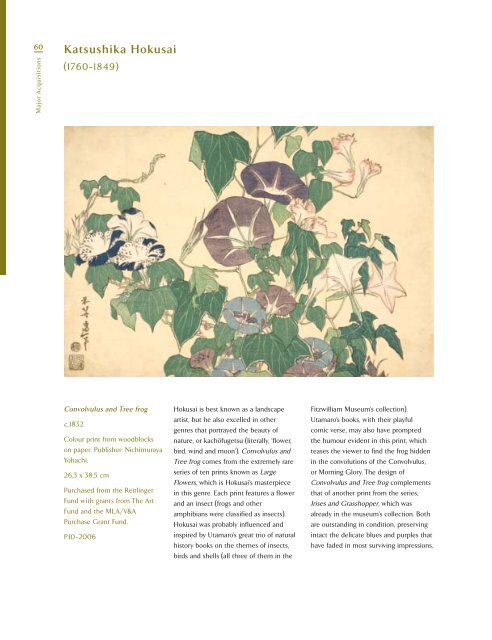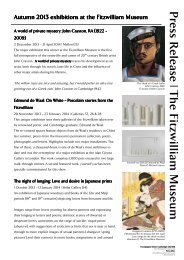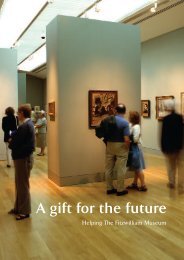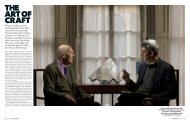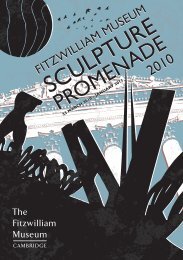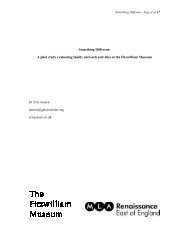The Fitzwilliam Museum - University of Cambridge
The Fitzwilliam Museum - University of Cambridge
The Fitzwilliam Museum - University of Cambridge
Create successful ePaper yourself
Turn your PDF publications into a flip-book with our unique Google optimized e-Paper software.
60 Katsushika Hokusai<br />
Major Acquisitions<br />
(1760–1849)<br />
Convolvulus and Tree frog<br />
c..1832<br />
Colour print from woodblocks<br />
on paper. Publisher: Nichimuraya<br />
Yohachi.<br />
26.3 x 38.5 cm<br />
Purchased from the Reitlinger<br />
Fund with grants from <strong>The</strong> Art<br />
Fund and the MLA/V&A<br />
Purchase Grant Fund.<br />
P.10-2006<br />
Hokusai is best known as a landscape<br />
artist, but he also excelled in other<br />
genres that portrayed the beauty <strong>of</strong><br />
nature, or kachÿfugetsu (literally, ‘flower,<br />
bird, wind and moon’). Convolvulus and<br />
Tree frog comes from the extremely rare<br />
series <strong>of</strong> ten prints known as Large<br />
Flowers, which is Hokusai’s masterpiece<br />
in this genre. Each print features a flower<br />
and an insect (frogs and other<br />
amphibians were classified as insects).<br />
Hokusai was probably influenced and<br />
inspired by Utamaro’s great trio <strong>of</strong> natural<br />
history books on the themes <strong>of</strong> insects,<br />
birds and shells (all three <strong>of</strong> them in the<br />
<strong>Fitzwilliam</strong> <strong>Museum</strong>’s collection).<br />
Utamaro’s books, with their playful<br />
comic verse, may also have prompted<br />
the humour evident in this print, which<br />
teases the viewer to find the frog hidden<br />
in the convolutions <strong>of</strong> the Convolvulus,<br />
or Morning Glory. <strong>The</strong> design <strong>of</strong><br />
Convolvulus and Tree frog complements<br />
that <strong>of</strong> another print from the series,<br />
Irises and Grasshopper, which was<br />
already in the museum’s collection. Both<br />
are outstanding in condition, preserving<br />
intact the delicate blues and purples that<br />
have faded in most surviving impressions.


